SUBARU IMPREZA 2006 2.G Workshop Manual
Manufacturer: SUBARU, Model Year: 2006, Model line: IMPREZA, Model: SUBARU IMPREZA 2006 2.GPages: 365, PDF Size: 7.09 MB
Page 51 of 365

1-24 Seat, seatbelt and SRS airbags
Where to place a child re-
straint system
The following are SUBARU s recommen-
dations on where to place a child restraint
system in your vehicle. A: Front passenger
s seat
You should not install a child restraint sys-
tem (including a booster seat) due to the
hazard to children posed by the passen-
ger s airbag.
B: Rear seat, window-side seating po-
sitions
Recommended positions for all types of
child restraint systems.
In these positions, Automatic/Emergency
Locking Retractor (A/ELR) seatbelts and
lower anchorages (bars) are provided for
installing a child restraint system.
Some types of child restraints might not
be able to be secured firmly due to projec-
tion of the seat cushion.
In this seating position, you should use
only a child restraint system that has a bottom base that fits snugly against the
contours of the seat cushion and can be
securely retained using the seatbelt.
C: Rear seat, center seating position
Installing a child restraint system is not
recommended, although the A/ELR seat-
belt and an upper anchorage (tether an-
chorage) are provided in this position.
Some types of child restraints might not
be able to be secured firmly due to projec-
tion of the seat cushion.
In this seating position, you should use
only a child restraint system that has a
bottom base that fits snugly against the
contours of the seat cushion and can be
securely retained using the seatbelt.
If it is unavoidable to install a child re-
straint system in the rear seat
s center
seating position, lower the center head re-
straint to the lowest position and install the
child restraint system by correctly passing
the rear center seatbelt through the belt
guide.
Children should be properly re-
strained at all times. Never allow a
child to stand up, or to kneel on any
seat. Unrestrained children will be
thrown forward during sudden stop
or in an accident and can be injured
seriously.
Additionally, children standing up
or kneeling on or in front of the front
seat are exposed another serious
danger. Since the SRS airbag de-
ploys with considerable speed and
force, the child could be injured or
even killed.
100127
Page 52 of 365
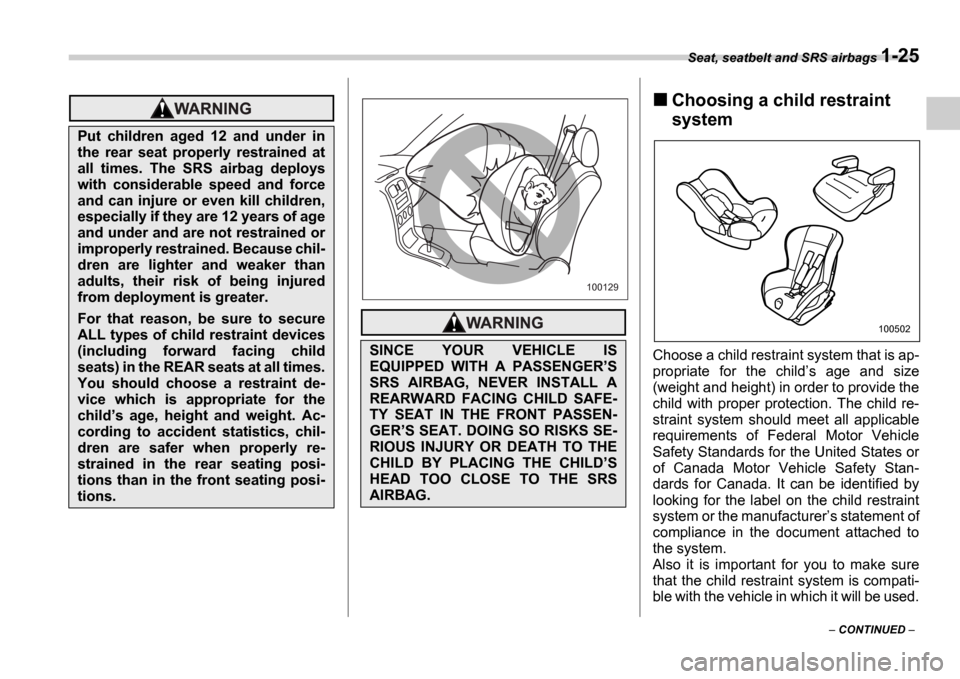
Seat, seatbelt and SRS airbags 1-25
CONTINUED
Choosing a child restraint
system
Choose a child restraint system that is ap-
propriate for the child s age and size
(weight and height) in order to provide the
child with proper protection. The child re-
straint system should meet all applicable
requirements of Federal Motor Vehicle
Safety Standards for the United States or
of Canada Motor Vehicle Safety Stan-
dards for Canada. It can be identified by
looking for the label on the child restraint
system or the manufacturer s statement of
compliance in the document attached to
the system.
Also it is important for you to make sure
that the child restraint system is compati-
ble with the vehicle in which it will be used.
Put children aged 12 and under in
the rear seat properly restrained at
all times. The SRS airbag deploys
with considerable speed and force
and can injure or even kill children,
especially if they are 12 years of age
and under and are not restrained or
improperly restrained. Because chil-
dren are lighter and weaker than
adults, their risk of being injured
from deployment is greater.
For that reason, be sure to secure
ALL types of child restraint devices
(including forward facing child
seats) in the REAR seats at all times.
You should choose a restraint de-
vice which is appropriate for the
child s age, height and weight. Ac-
cording to accident statistics, chil-
dren are safer when properly re-
strained in the rear seating posi-
tions than in the front seating posi-
tions.
SINCE YOUR VEHICLE IS
EQUIPPED WITH A PASSENGER S
SRS AIRBAG, NEVER INSTALL A
REARWARD FACING CHILD SAFE-
TY SEAT IN THE FRONT PASSEN-
GER S SEAT. DOING SO RISKS SE-
RIOUS INJURY OR DEATH TO THE
CHILD BY PLACING THE CHILD S
HEAD TOO CLOSE TO THE SRS
AIRBAG.
100129
100502
Page 53 of 365
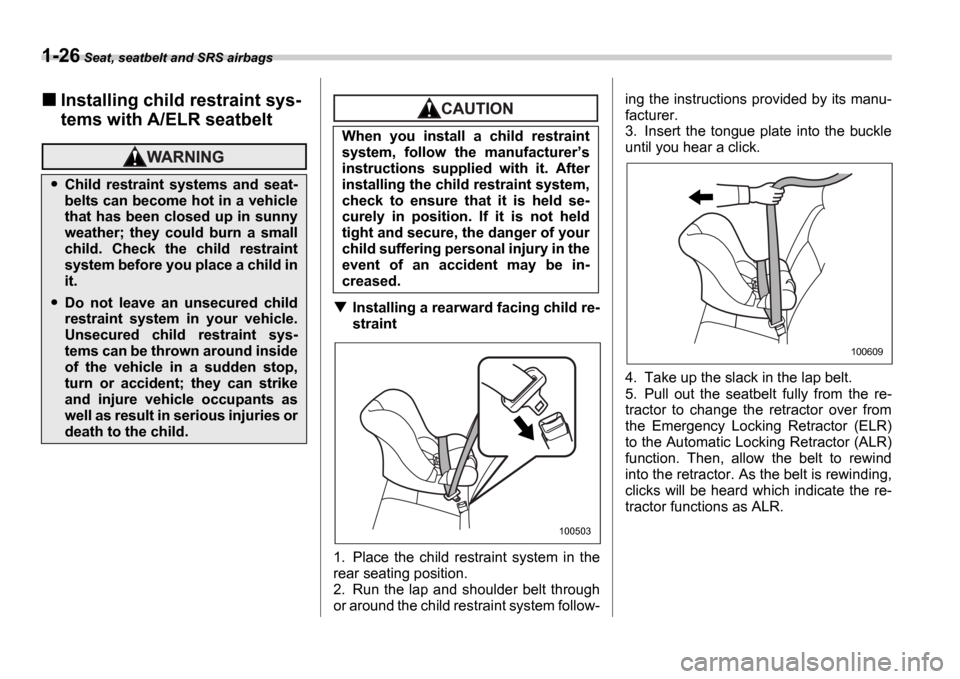
1-26 Seat, seatbelt and SRS airbags
Installing child restraint sys-
tems with A/ELR seatbelt
Installing a rearward facing child re-
straint
1. Place the child restraint system in the
rear seating position.
2. Run the lap and shoulder belt through
or around the child restraint system follow- ing the instructions provided by its manu-
facturer.
3. Insert the tongue plate into the buckle
until you hear a click.
4. Take up the slack in the lap belt.
5. Pull out the seatbelt fully from the re-
tractor to change the retractor over from
the Emergency Locking Retractor (ELR)
to the Automatic Locking Retractor (ALR)
function. Then, allow the belt to rewind
into the retractor. As the belt is rewinding,
clicks will be heard which indicate the re-
tractor functions as ALR.
Child restraint systems and seat-
belts can become hot in a vehicle
that has been closed up in sunny
weather; they could burn a small
child. Check the child restraint
system before you place a child in
it.
Do not leave an unsecured child
restraint system in your vehicle.
Unsecured child restraint sys-
tems can be thrown around inside
of the vehicle in a sudden stop,
turn or accident; they can strike
and injure vehicle occupants as
well as result in serious injuries or
death to the child.
When you install a child restraint
system, follow the manufacturer
s
instructions supplied with it. After
installing the child restraint system,
check to ensure that it is held se-
curely in position. If it is not held
tight and secure, the danger of your
child suffering personal injury in the
event of an accident may be in-
creased.
100503
100609
Page 54 of 365
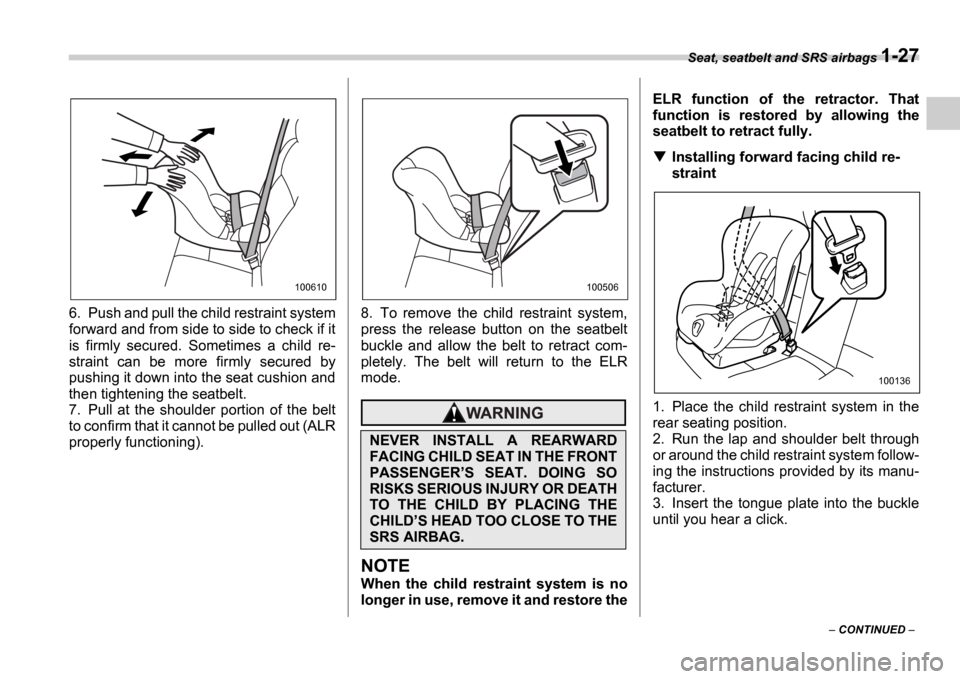
Seat, seatbelt and SRS airbags 1-27
CONTINUED
6. Push and pull the child restraint system
forward and from side to side to check if it
is firmly secured. Sometimes a child re-
straint can be more firmly secured by
pushing it down into the seat cushion and
then tightening the seatbelt.
7. Pull at the shoulder portion of the belt
to confirm that it cannot be pulled out (ALR
properly functioning).
8. To remove the child restraint system,
press the release button on the seatbelt
buckle and allow the belt to retract com-
pletely. The belt will return to the ELR
mode.
NOTE
When the child restraint system is no
longer in use, remove it and restore theELR function of the retractor. That
function is restored by allowing the
seatbelt to retract fully.
Installing forward facing child re-
straint
1. Place the child restraint system in the
rear seating position.
2. Run the lap and shoulder belt through
or around the child restraint system follow-
ing the instructions provided by its manu-
facturer.
3. Insert the tongue plate into the buckle
until you hear a click.
100610
NEVER INSTALL A REARWARD
FACING CHILD SEAT IN THE FRONT
PASSENGER S SEAT. DOING SO
RISKS SERIOUS INJURY OR DEATH
TO THE CHILD BY PLACING THE
CHILD S HEAD TOO CLOSE TO THE
SRS AIRBAG.
100506
100136
Page 55 of 365
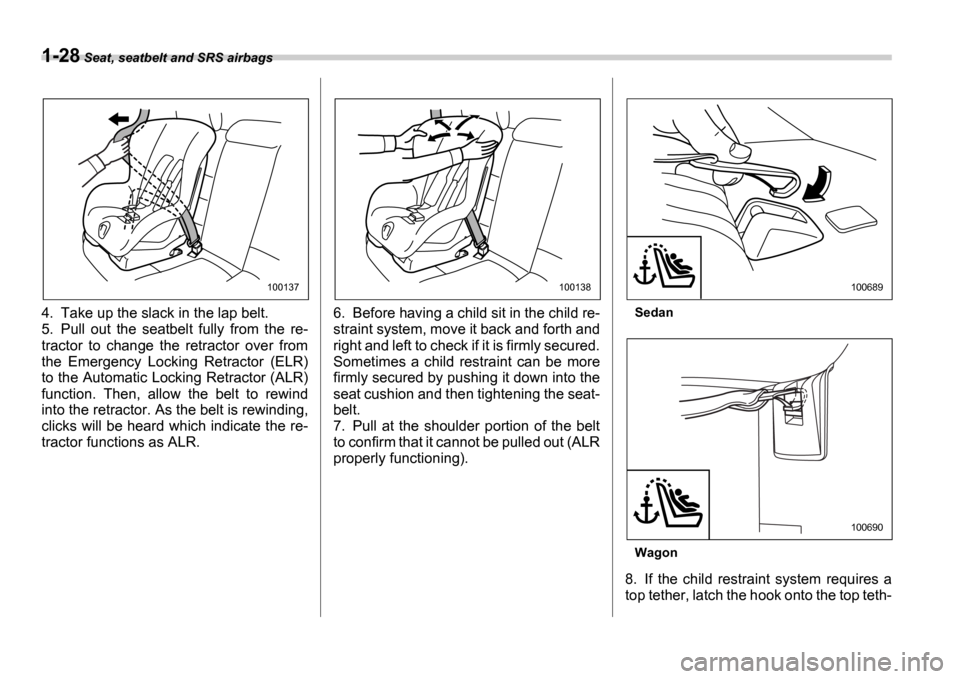
1-28 Seat, seatbelt and SRS airbags
4. Take up the slack in the lap belt.
5. Pull out the seatbelt fully from the re-
tractor to change the retractor over from
the Emergency Locking Retractor (ELR)
to the Automatic Locking Retractor (ALR)
function. Then, allow the belt to rewind
into the retractor. As the belt is rewinding,
clicks will be heard which indicate the re-
tractor functions as ALR. 6. Before having a child sit in the child re-
straint system, move it back and forth and
right and left to check if it is firmly secured.
Sometimes a child restraint can be more
firmly secured by pushing it down into the
seat cushion and then tightening the seat-
belt.
7. Pull at the shoulder portion of the belt
to confirm that it cannot be pulled out (ALR
properly functioning).Sedan
Wagon
8. If the child restraint system requires a
top tether, latch the hook onto the top teth-
100137100138100689
100690
Page 56 of 365
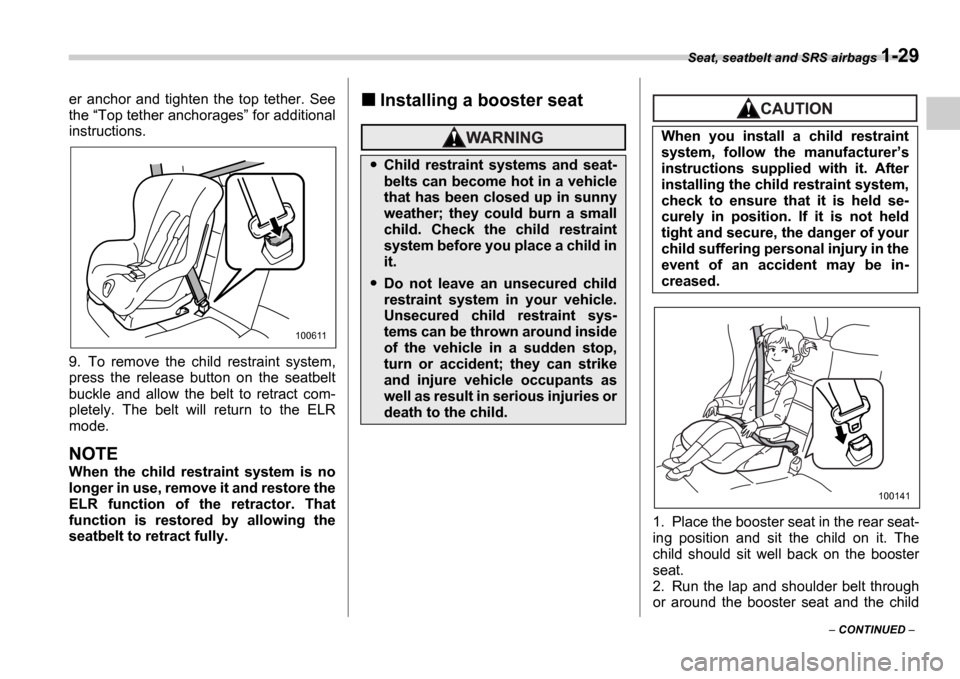
Seat, seatbelt and SRS airbags 1-29
CONTINUED
er anchor and tighten the top tether. See
the
Top tether anchorages for additional
instructions.
9. To remove the child restraint system,
press the release button on the seatbelt
buckle and allow the belt to retract com-
pletely. The belt will return to the ELR
mode.
NOTE
When the child restraint system is no
longer in use, remove it and restore the
ELR function of the retractor. That
function is restored by allowing the
seatbelt to retract fully.
Installing a booster seat
1. Place the booster seat in the rear seat-
ing position and sit the child on it. The
child should sit well back on the booster
seat.
2. Run the lap and shoulder belt through
or around the booster seat and the child
100611
Child restraint systems and seat-
belts can become hot in a vehicle
that has been closed up in sunny
weather; they could burn a small
child. Check the child restraint
system before you place a child in
it.
Do not leave an unsecured child
restraint system in your vehicle.
Unsecured child restraint sys-
tems can be thrown around inside
of the vehicle in a sudden stop,
turn or accident; they can strike
and injure vehicle occupants as
well as result in serious injuries or
death to the child.
When you install a child restraint
system, follow the manufacturer s
instructions supplied with it. After
installing the child restraint system,
check to ensure that it is held se-
curely in position. If it is not held
tight and secure, the danger of your
child suffering personal injury in the
event of an accident may be in-
creased.
100141
Page 57 of 365
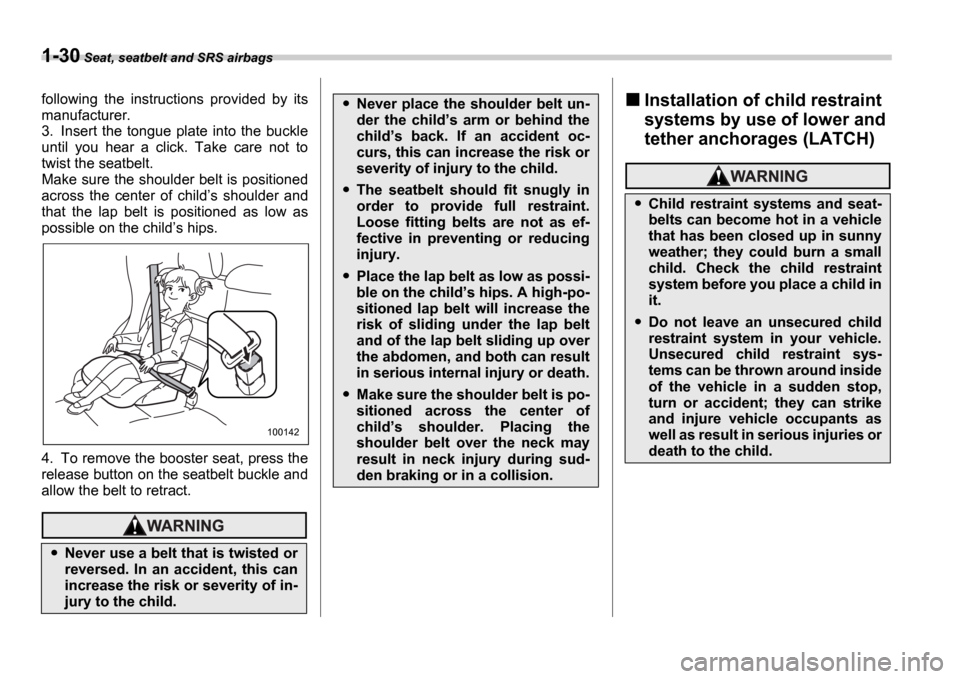
1-30 Seat, seatbelt and SRS airbags
following the instructions provided by its
manufacturer.
3. Insert the tongue plate into the buckle
until you hear a click. Take care not to
twist the seatbelt.
Make sure the shoulder belt is positioned
across the center of child s shoulder and
that the lap belt is positioned as low as
possible on the child s hips.
4. To remove the booster seat, press the
release button on the seatbelt buckle and
allow the belt to retract.Installation of child restraint
systems by use of lower and
tether anchorages (LATCH)
Never use a belt that is twisted or
reversed. In an accident, this can
increase the risk or severity of in-
jury to the child.
100142
Never place the shoulder belt un-
der the child s arm or behind the
child s back. If an accident oc-
curs, this can increase the risk or
severity of injury to the child.
The seatbelt should fit snugly in
order to provide full restraint.
Loose fitting belts are not as ef-
fective in preventing or reducing
injury.
Place the lap belt as low as possi-
ble on the child s hips. A high-po-
sitioned lap belt will increase the
risk of sliding under the lap belt
and of the lap belt sliding up over
the abdomen, and both can result
in serious internal injury or death.
Make sure the shoulder belt is po-
sitioned across the center of
child s shoulder. Placing the
shoulder belt over the neck may
result in neck injury during sud-
den braking or in a collision.
Child restraint systems and seat-
belts can become hot in a vehicle
that has been closed up in sunny
weather; they could burn a small
child. Check the child restraint
system before you place a child in
it.
Do not leave an unsecured child
restraint system in your vehicle.
Unsecured child restraint sys-
tems can be thrown around inside
of the vehicle in a sudden stop,
turn or accident; they can strike
and injure vehicle occupants as
well as result in serious injuries or
death to the child.
Page 58 of 365
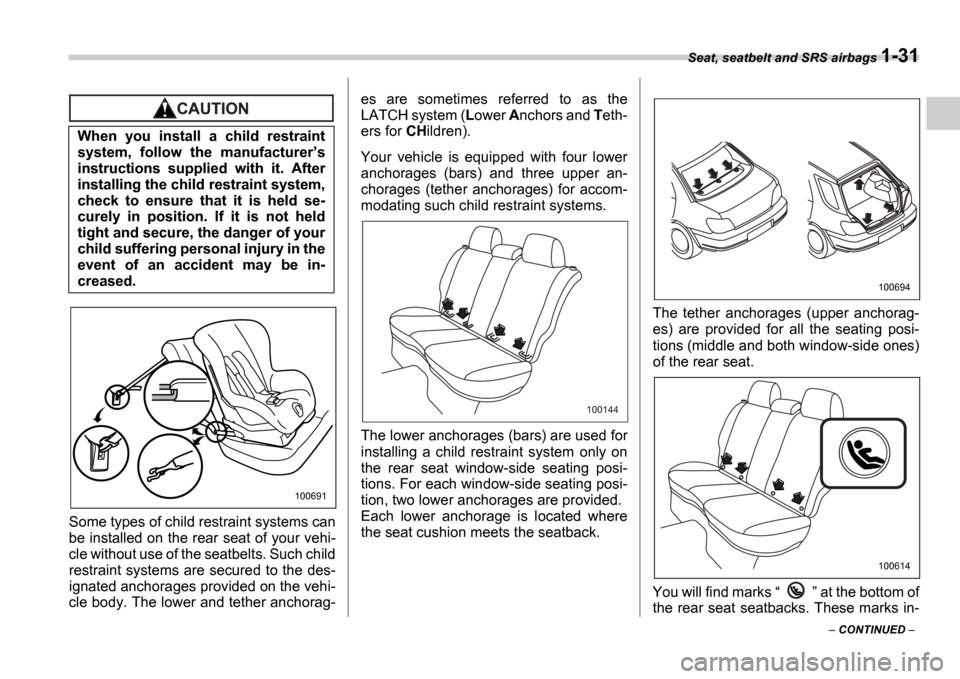
Seat, seatbelt and SRS airbags 1-31
CONTINUED
Some types of child restraint systems can
be installed on the rear seat of your vehi-
cle without use of the seatbelts. Such child
restraint systems are secured to the des-
ignated anchorages provided on the vehi-
cle body. The lower and tether anchorag- es are sometimes referred to as the
LATCH system (
Lower Anchors and Teth-
ers for CHildren).
Your vehicle is equipped with four lower
anchorages (bars) and three upper an-
chorages (tether anchorages) for accom-
modating such child restraint systems.
The lower anchorages (bars) are used for
installing a child restraint system only on
the rear seat window-side seating posi-
tions. For each window-side seating posi-
tion, two lower anchorages are provided.
Each lower anchorage is located where
the seat cushion meets the seatback. The tether anchorages (upper anchorag-
es) are provided for all the seating posi-
tions (middle and both window-side ones)
of the rear seat.
You will find marks
at the bottom of
the rear seat seatbacks. These marks in-
When you install a child restraint
system, follow the manufacturer
s
instructions supplied with it. After
installing the child restraint system,
check to ensure that it is held se-
curely in position. If it is not held
tight and secure, the danger of your
child suffering personal injury in the
event of an accident may be in-
creased.
100691
100144
100694
100614
Page 59 of 365
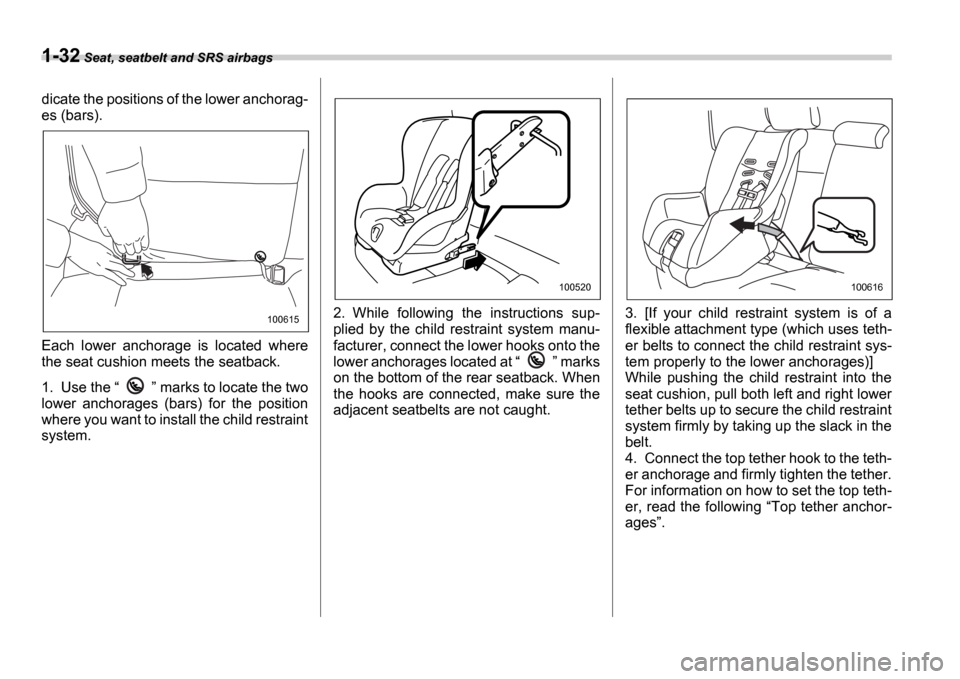
1-32 Seat, seatbelt and SRS airbags
dicate the positions of the lower anchorag-
es (bars).
Each lower anchorage is located where
the seat cushion meets the seatback.
1. Use the marks to locate the two
lower anchorages (bars) for the position
where you want to install the child restraint
system. 2. While following the instructions sup-
plied by the child restraint system manu-
facturer, connect the lower hooks onto the
lower anchorages located at
marks
on the bottom of the rear seatback. When
the hooks are connected, make sure the
adjacent seatbelts are not caught. 3. [If your child restraint system is of a
flexible attachment type (which uses teth-
er belts to connect the child restraint sys-
tem properly to the lower anchorages)]
While pushing the child restraint into the
seat cushion, pull both left and right lower
tether belts up to secure the child restraint
system firmly by taking up the slack in the
belt.
4. Connect the top tether hook to the teth-
er anchorage and firmly tighten the tether.
For information on how to set the top teth-
er, read the following
Top tether anchor-
ages .
100615
100520100616
Page 60 of 365
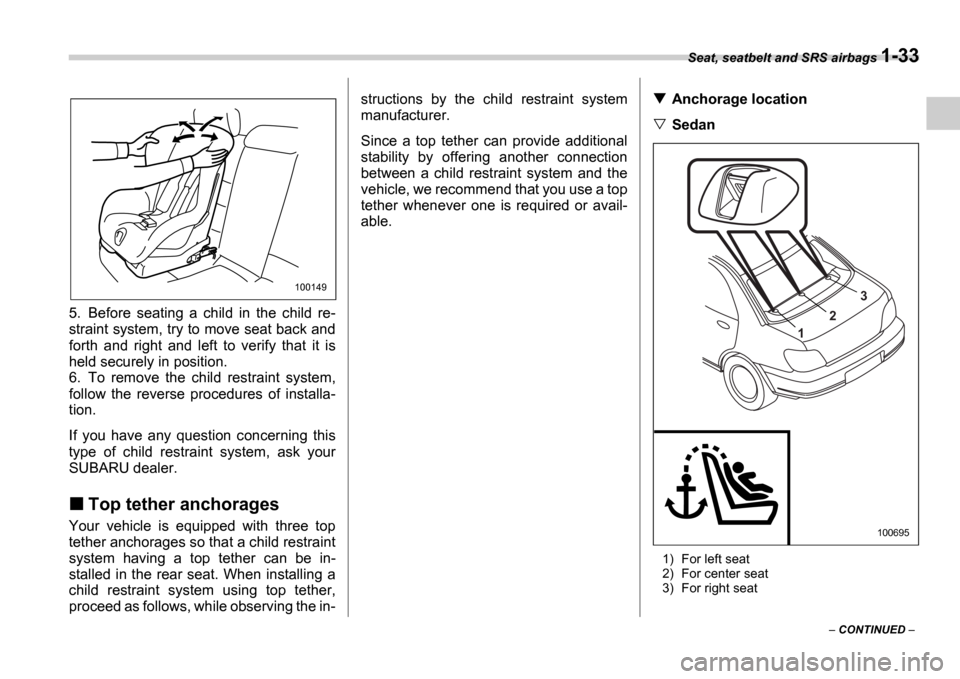
Seat, seatbelt and SRS airbags 1-33
CONTINUED
5. Before seating a child in the child re-
straint system, try to move seat back and
forth and right and left to verify that it is
held securely in position.
6. To remove the child restraint system,
follow the reverse procedures of installa-
tion.
If you have any question concerning this
type of child restraint system, ask your
SUBARU dealer.
Top tether anchorages
Your vehicle is equipped with three top
tether anchorages so that a child restraint
system having a top tether can be in-
stalled in the rear seat. When installing a
child restraint system using top tether,
proceed as follows, while observing the in- structions by the child restraint system
manufacturer.
Since a top tether can provide additional
stability by offering another connection
between a child restraint system and the
vehicle, we recommend that you use a top
tether whenever one is required or avail-
able.
Anchorage location
Sedan
1) For left seat
2) For center seat
3) For right seat
100149
1
23
100695